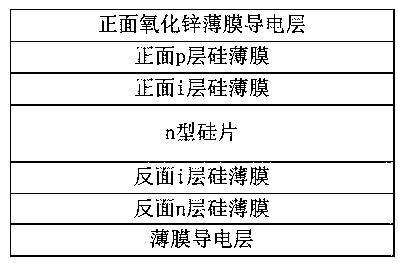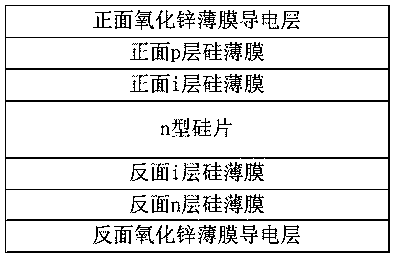Heterojunction solar cell based on n-type silicon wafer and manufacturing method thereof
A technology of a solar cell and a manufacturing method, which is applied in the field of solar cells, can solve the problems of complex process, expensive equipment, complicated manufacturing process and equipment, etc., and achieves the effect of increasing the light absorption area and simplifying the manufacturing process
- Summary
- Abstract
- Description
- Claims
- Application Information
AI Technical Summary
Problems solved by technology
Method used
Image
Examples
Embodiment 1
[0037] A heterojunction solar cell based on an n-type silicon wafer, comprising an n-type silicon wafer, an i-layer silicon thin film on the front side, a p-layer silicon thin film on the front side, an i-layer silicon thin film on the back side, an n-layer silicon thin film on the back side, and a zinc oxide thin film conductive layer on the front side and a thin film conductive layer, where:
[0038] The front side of the n-type silicon wafer is deposited with a front i-layer silicon film by plasma chemical vapor deposition PECVD method, and a front p-layer silicon film is deposited on the front i-layer silicon film by plasma chemical vapor deposition PECVD method, and a front p-layer silicon film is deposited on the front side i-layer silicon film The conductive layer of zinc oxide thin film on the upper side is deposited by chemical vapor deposition CVD method, and the i-layer silicon film on the reverse side is deposited by plasma chemical vapor deposition PECVD method on ...
Embodiment 2
[0046] A heterojunction solar cell based on n-type silicon wafers, such as figure 2 , including an n-type silicon wafer, an i-layer silicon film on the front side, a p-layer silicon film on the front side, an i-layer silicon film on the back side, an n-layer silicon film on the back side, a conductive layer of a transparent zinc oxide film on the front side and a conductive layer of a zinc oxide thin film on the back side, wherein:
[0047] The front side of the n-type silicon wafer is deposited with a front i-layer silicon film by plasma chemical vapor deposition PECVD method, and a front p-layer silicon film is deposited on the front i-layer silicon film by plasma chemical vapor deposition PECVD method, and a front p-layer silicon film is deposited on the front side i-layer silicon film The conductive layer of zinc oxide thin film on the upper side is deposited by chemical vapor deposition CVD method, and the i-layer silicon film on the reverse side is deposited by plasma ch...
PUM
 Login to View More
Login to View More Abstract
Description
Claims
Application Information
 Login to View More
Login to View More - R&D
- Intellectual Property
- Life Sciences
- Materials
- Tech Scout
- Unparalleled Data Quality
- Higher Quality Content
- 60% Fewer Hallucinations
Browse by: Latest US Patents, China's latest patents, Technical Efficacy Thesaurus, Application Domain, Technology Topic, Popular Technical Reports.
© 2025 PatSnap. All rights reserved.Legal|Privacy policy|Modern Slavery Act Transparency Statement|Sitemap|About US| Contact US: help@patsnap.com


